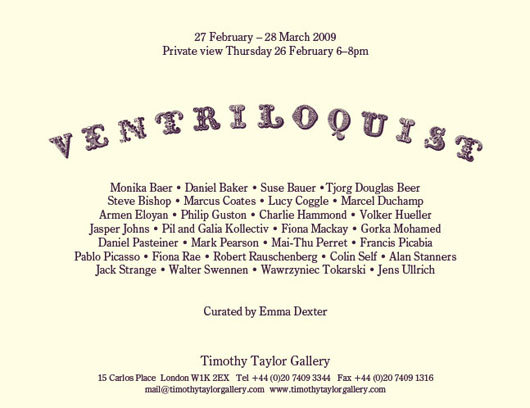Ventriloquist
dal 25/2/2009 al 27/3/2009
Segnalato da
Monika Baer
Daniel Baker
Suse Bauer
Tjorg Douglas Beer
Steve Bisho
Marcus Coates
Lucy Coggle
Marcel Duchamp
Armen Eloyan
Philip Guston
Charlie Hammond
Volker Hueller
Jasper Johns
Pil and Galia Kollectiv
Fiona Mackay
Gorka Mohamed
Daniel Pasteiner
Mark Pearson
Mai-Thu Perret
Francis Picabia
Pablo Picasso
Fiona Rae
Robert Rauschenberg
Colin Self
Alan Stanners
Jack Strange
Walter Swennen
Wawrzyniec Tokarski
Jens Ullrich
25/2/2009
Ventriloquist
Timothy Taylor Gallery, London
A group show that links works by some of the 20th century's greatest artists with those of a younger generation of established and emerging talent. The exhibition explores how artists use distancing techniques to mask the author, employ ciphers and symbols and create alter-egos, fantastical self portraits, animal surrogates or even new hypothetical realms.

Monika Baer - Daniel Baker - Suse Bauer - Tjorg Douglas Beer - Steve Bishop
Marcus Coates - Lucy Coggle - Marcel Duchamp - Armen Eloyan - Philip Guston
Charlie Hammond - Volker Hueller - Jasper Johns - Pil and Galia Kollectiv - Fiona Mackay
Gorka Mohamed - Daniel Pasteiner - Mark Pearson - Mai-Thu Perret - Francis Picabia
Pablo Picasso - Fiona Rae - Robert Rauschenberg - Colin Self - Alan Stanners
Jack Strange - Walter Swennen - Wawrzyniec Tokarski - Jens Ullrich
Timothy Taylor Gallery is delighted to present Ventriloquist, a group show that links works by
some of the 20th centuryʼs greatest artists with those of a younger generation of established
and emerging talent.
Ventriloquism – the act of stagecraft by which the performer manipulates his or her own voice
so that it appears to come from elsewhere, is also described as the ability to "throw" one's
own voice. However, the term "throwing one's voice" is misleading - implying that a sound's
physical origin has changed, when really the change has been perceptual and
not physical. Taking its title from a work by Jasper Johns included in the exhibition,
Ventriloquist explores how artists use ʻdistancingʼ techniques to mask the author, employ
ciphers and symbols and create alter-egos, fantastical self portraits, animal surrogates or
even new hypothetical realms. It also explores the use of text and language which, through
the influence of Freud, Dada and Surrealism, opened the door to wordplay and games,
multiple meanings and associations.
In Jasper Johnʼs Untitled (Ventriloquist), 1984, the artist uses the voices of others to conjure
up an enigmatic and alternative vision of Americanness: the painting juxtaposes the outline of
Herman Melvilleʼs ʻMoby Dickʼ (channelled through an engraving by Barry Moser) with the
work of the eccentric 19th century Biloxi potter George Ohr, an iconic American figure, who
was hailed mid 20th century as a harbinger of abstraction.
Challenging art rules and upsetting bourgeois sensibilities, Dada and Surrealism introduced
word games and double-entendres to the realm of art. In Duchampʼs L.H.O.O.Q. Shaved,
1965, the artist reworked his famous moustache-sporting Mona Lisa by creating another
version, this time without the facial hair – thereby creating the ultimate ready-made/
appropriationist artwork. The title L.H.O.O.Q. is a phonetic game: when read quickly in
French, it sounds like a sentence that roughly translates as ʻshe has a hot assʼ.
Francis Picabiaʼs Untitled, 1948–50, reveals the influence upon the artist of Nietszcheʼs The
Gay Science, in which the German philosopher extols in poetry and prose the legacy of the
Provençal troubadour tradition and its joyful affirmation of life. Ferociously unconventional
throughout his life and a key participant in Dadaʼs anti-art stance, Picabia, at the end of his
career, returned to graphic abstraction to explore the nature of life and art, fear, joy and love;
strong lines and earthy colour and imagery combine in this primitive and phallic head, strongly
reminiscent of pre-Cycladic and Iberian fertility imagery.
In Docket of Violation, 1954, Robert Rauschenbergʼs collage testifies to another vision of
America constructed through found materials: the docket and the Statue of Liberty conjure
the power and the promise of the land of the free. The exhibition also features Philip Gustonʼs
late figurative work Inside Outside, 1977. Guston employs his personal symbolic language to
create his trademark lugubrious and claustrophobic world; bugs, boots, bottles and trash-cans
all combine to create a stark existential meditation.
In addition, the exhibition includes Mr Foxy, 2008, an endearing anthropomorphic portrait by
the Armenian painter Armen Eloyan, a video by Marcus Coates exploring the thin line
between the human and animal worlds and Monica Baerʼs disintegrating and dissolving
money paintings. Misleading and erroneous self-portraits are provided by Charlie Hammond,
Jack Strange, Fiona Mackay and Volker Hueller, while Suse Bauer presents a symbolic
portrait of Anne Frank. Text plays an important role in laying false trails, with diaristic extracts
from Mai-Thu Perretʼs meta-narrative The Crystal Frontier; and Daniel Bakerʼs mirrored texts
and Lucy Cogglesʼ nonsense spreading ambiguity and confusion. An early Fiona Rae painting
suggests an imaginary pictogram language, while Wawrzyniec Tokarski and Mark Pearson
both use strongly associative graphics and text to question traditional power structures.
Private View 26 February 2009 | 6-8pm
Timothy Taylor Gallery
21 Dering Street - London
Monday to Friday 10am — 6pm Saturday 10am — 1pm
Free admission



